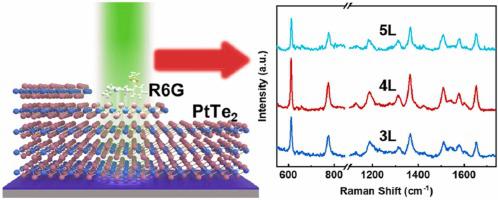Journal of Alloys and Compounds ( IF 6.2 ) Pub Date : 2022-11-30 , DOI: 10.1016/j.jallcom.2022.168294 Zehong Lei , Dongsi Wu , Xuanhao Cao , Xinkuo Zhang , Lili Tao , Zhaoqiang Zheng , Xing Feng , Li Tao , Yu Zhao

|
Two-dimensional (2D) materials have drawn ever-increasing interest for the application of surface-enhanced Raman scattering (SERS) because of their low-cost synthesis, non-toxic characteristics, flat surface and outstanding optical properties. The unique thickness-dependent SERS of 2D materials is intriguing, however, the underlying mechanism of this phenomenon is not fully understood. In this work, the few-layer platinum telluride (PtTe2), an emerging 2D type-II Dirac semimetal with strong interlayer interaction, is explored as a potential SERS substrate. The Raman enhancement on 2D PtTe2 is confirmed experimentally to be originated from the predominant charge transfer mechanism. The unique thickness-dependent SERS effect reveals that four-layer (4 L) PtTe2 exhibits the strongest Raman intensity of probe molecule Rhodamine 6 G (R6G). Combined with the theoretical investigation by density functional theory (DFT), the ultrasensitive SERS effect of 4 L PtTe2 is found to be attributed to its high density of states (DOS) near the Fermi level and strongest built-in electric field at the interface of molecule/PtTe2. R6G, crystal violet (CV) and rhodamine B (RhB) on 4 L PtTe2 all reach a detection limit as low as 10−10 M. The uniformity, stability and photobleaching effect of PtTe2 as SERS substrate is also studied. Our findings reveal that the charge transfer between molecule and 2D materials is a complex process that is influenced by multiple factors, which might deepen our understanding of the unique chemical mechanism (CM) of SERS in 2D materials.
中文翻译:

二维碲化铂作为 SERS 衬底:独特的层依赖拉曼增强效应
二维 (2D) 材料由于其合成成本低、无毒、表面平整和出色的光学性能,在表面增强拉曼散射 (SERS) 应用中引起了越来越多的兴趣。二维材料独特的依赖于厚度的 SERS 很有趣,但是,这种现象的潜在机制尚不完全清楚。在这项工作中,研究了多层碲化铂 (PtTe 2 ),一种新兴的具有强层间相互作用的二维 II 型狄拉克半金属,作为潜在的 SERS 衬底进行了探索。2D PtTe 2上的拉曼增强通过实验证实源自主要的电荷转移机制。独特的依赖于厚度的 SERS 效应揭示了四层 (4 L) PtTe 2表现出探针分子罗丹明 6 G (R6G) 的最强拉曼强度。结合密度泛函理论(DFT)的理论研究,发现4 L PtTe 2的超灵敏SERS效应归因于其在费米能级附近的高态密度(DOS)和界面处最强的内建电场分子/PtTe 2。R6G、结晶紫(CV)和罗丹明B(RhB)在4 L PtTe 2上均达到低至10 -10 M的检测限。PtTe 2的均匀性、稳定性和光漂白效果作为 SERS 基板也进行了研究。我们的研究结果表明,分子和二维材料之间的电荷转移是一个受多种因素影响的复杂过程,这可能会加深我们对二维材料中 SERS 独特化学机制 (CM) 的理解。


























 京公网安备 11010802027423号
京公网安备 11010802027423号